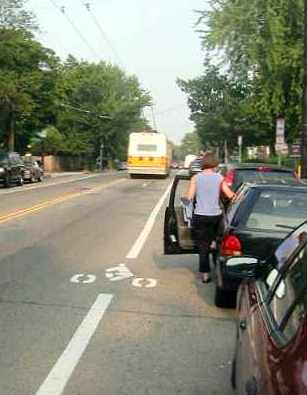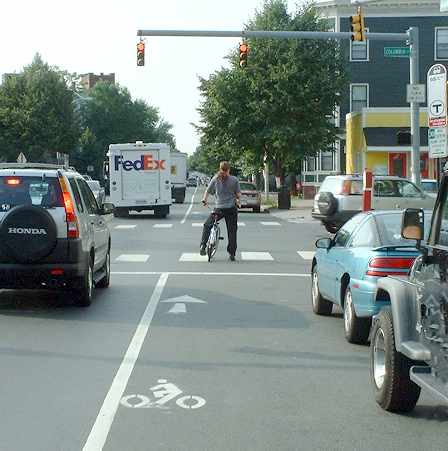 Bryce Nesbitt photo |
Top: Home Page
Up: Cambridge bicycle facilities and program
Previous:
Next:
| A "bike line" is a single painted line, more or less in the location of a
guide stripe at the right side of the travel lane on a roadway, and marked every so often
with a bicycle symbol. A bike line generally is intended to indicate a preferred or
recommended line of travel for bicyclists, and to remind motorists that bicyclists use a
roadway. Unlike a bike lane, a bike line inherently can not restrict bicyclists to a precisely-defined part of the roadway's width: a bicyclist is much wider than the line, which does not identify a boundary as an ordinary lane line does. Whether a bike line identifies a boundary for motorists is not clear, given that it does not identify one for bicyclists. However, the bike line is continuous, and so it is inherently more prescriptive than the Denver lane-sharing arrow and other similar treatments which attempt to indicate a preferred line of travel without specifying it precisely. Mt. Auburn Street, 2002During or before 2002, the city of Cambridge, Massachusetts installed bike lines on Mt. Auburn Street west of Sparks Street and east of Fresh Pond Parkway. The bike line shown in the photo below places bicyclists just at the limit of the "door zone" for a small sedan. The bike line might be considered as a substitute for a bike lane, a reminder to motorists that bicyclists are present. If it is interpreted as prescriptive, then in the situation shown, it would require bicyclists to ride too close to parked vehicles. The travel lane to its left is too narrow to allow the widest vehicles, such as the trackless trolley in the photo, to overtake bicyclists safely without intruding somewhat into the lane to their left. There is no standard interpretation, as the bike line is a nonstandard marking whose meaning is not spelled out in the law. |
Bike line on Mt. Auburn Street, Cambridge, Massachusetts
 Bryce Nesbitt photo |
Hampshire Street and Massachusetts Avenue, 2003In 2003 and 2004, Cambridge conducted a research project to determine the effect of different markings on bicyclists' choice of a line of travel. New bike lines were installed on Hampshire Street east of Inman Square, and on Massachusetts Avenue north of Porter Square. The bicycle symbols and directional arrows on Hampshire Street were placed to the right of the bike line, as shown in the photo below. This gives the appearance of a combined bike lane/parking lane with only a left-side stripe. |
Hampshire Street looking west at the intersection
with Columbia Street, August, 2003

| This positioning was part of an experiment for a study of different markings, and a few weeks later, a second stripe was painted, converting the bike line into a conventional Cambridge door-zone, "trolley track" bike lane -- with solid lines all the way to the corner, as has been the city's practice in recent years. |
Hampshire Street looking west at the intersection
with Columbia Street, September, 2003

| The bike lines on Massachusetts Avenue (photo below) had the bicycle symbols placed more normally within them, but the adjacent travel lane is narrower here than on Mt. Auburn Street, and the bike lines are so close to parked vehicles that they can not possibly serve as indications of a line of travel. The Massachusetts Avenue bike lines remain unchanged as of the summer of 2004. |
Bike line in the taillight zone,
Massachusetts Avenue looking south, just south of Cedar Street,
September, 2003

What is to do?In this author's opinion, the "bike line" is an unsatisfactory marking. Bicyclists' best line of travel depends on traffic conditions (e.g., whether parking spaces are occupied) and the bicyclists' destination -- but a bike line indicates only a single line of travel, rather than a range, and so it gives the impression of being even more restrictive than a conventional bike lane. If there is parallel parking and there is not room for a shared travel lane or bike lane outside the range of open doors of parked vehicles, safety requires that bicyclists ride in line with motor traffic. A bike line appears to be an edge stripe for motorists as well as an indication of a line of travel for bicyclists, and so its intention is confusing even if there is room for motorists to overtake. And the continuous stripe of paint in a bicyclist's line of travel may be slippery when wet. If sufficient width is not available for lane sharing, measures which may work better include lane-sharing arrows and share-the-road signs. Measures to control the speed of motor traffic, including law enforcement and speed humps, can make a street with narrow lanes more attractive for bicycling. Another possibility is to indicate and improve alternate preferred routes. |
Top: Home Page
Up: Cambridge bicycle facilities and program
Previous:
Next: